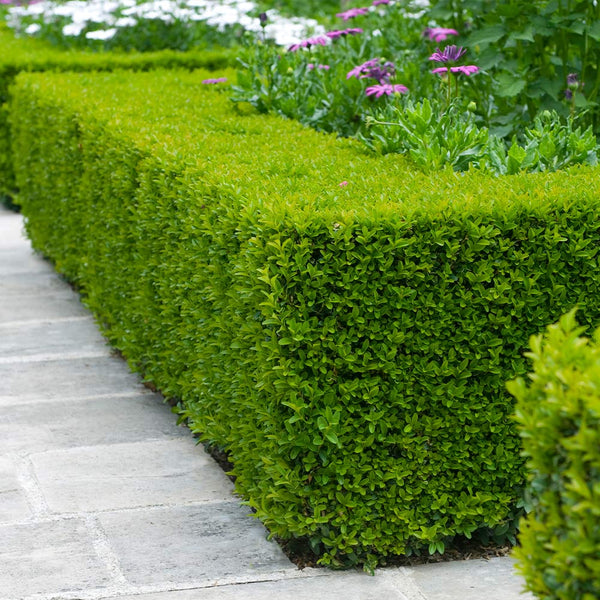Why Plant Wintergreen Boxwood
Buxus microphylla, which goes by the name Wintergreen Boxwood, has sustained its worth throughout hundreds of years because of its durability alongside its visual charm and versatility. During the Tang Dynasty (618–907 AD), it found its origins in Japan and China, where its dense evergreen foliage gained high esteem. By the 18th century European explorers who discovered this plant during the 17th century had successfully introduced it into formal garden landscapes throughout the continent. England and France noble estates quickly adopted it as a crucial component in their complex garden schemes. Regular pruning did not harm it and thus made it a common feature in parterre gardens where it represented order and refinement.
The plant reached North America during the 19th century through expanding trade routes and became essential to colonial gardens. Settlers in early colonial times found this plant desirable because it maintained elegance for extended periods due to its durable nature and gradual growth. This plant gradually established itself as an ornamental favorite before it reached iconic status in sophisticated landscapes throughout temperate areas around the world.
Wintergreen Boxwood Medicinal Uses Through the Ages
Different cultures throughout history investigated medicinal uses for Buxus microphylla. Ancient Chinese herbalists identified properties in its leaves that could soothe skin ailments and treat minor wounds. Medieval Europeans created tonics from the plant's leaf and bark extracts to treat rheumatism and fever symptoms. During the 16th century, physicians created salves from its oils to treat joint pain and inflammation.
The medical community has discontinued the use of Wintergreen Boxwood because of its toxic alkaloids even though it was historically employed in medicine. Traditional herbalists maintain awareness of its historical application in folk medicine. Researchers today investigate its chemical compounds to uncover antimicrobial properties that secure its position among historically important healing plants.
The First Discovery of Buxus Microphylla
Although the plant has existed for thousands of years, scientists only classified it formally during the 18th century. As European botanists explored East Asia they recorded detailed notes about the plant which highlighted its dense structure and ability to thrive in different soil types. Carl Linnaeus revolutionized plant taxonomy through his Swedish naturalist work when he incorporated this species into botanical literature that established its importance in horticultural history.
The Japanese nurtured and designed this plant across many generations, paying special attention to temple gardens to represent harmony and longevity. The growing Western fascination with Asian gardening practices led to increased importation of the plant until it became a fundamental element in gardens worldwide.
Wintergreen Boxwood's Role in Landscapes and Garden Design
It functions as a fundamental plant in landscape architecture which establishes strong foundations for gardens of both traditional and modern styles. The plant's persistent green foliage and limited growth pattern make it perfect for outlining boundaries, sculpting hedges and designing elaborate topiary structures.
The French parterre garden design depends on geometric precision which wintergreen boxwood helps maintain while English cottage gardens use it to structure their natural, yet composed floral displays. Landscape designers today utilize this material to establish clean lines and sculptural features that deliver perennial foliage that ties outdoor spaces together.

The ability of this plant to thrive in shaded areas and different soil types makes it ideal for urban settings where it frequently appears in parks, courtyards and business landscapes. This plant serves as a fundamental element of refined garden design when it stands alone or creates a maintenance-free hedge.
The Aesthetic Appeal and Physical Characteristics
Buxus microphylla has maintained its status as a popular garden plant for hundreds of years because of its sophisticated grace. The plant displays small oval leaves that have a glossy finish producing a thick and rich-looking texture. The plant's foliage takes on colors from deep emerald to light green according to sunlight exposure but keeps its vibrancy across all seasons which maintains visual interest.
Its natural growth pattern remains compact which makes it perfect for crafting shapes unlike other evergreen plants that tend to become unmanageable. This plant displays small pale green flowers during early spring which create understated beauty without compromising its tidy appearance. The main attraction of this plant comes from its foliage but its pale flowers bring in pollinators which improves its ecological importance.
This plant grows densely and gradually which enables it to maintain its shape while requiring little pruning. This plant achieves an unmatched timeless beauty in landscapes whether it develops naturally or is carefully shaped into decorative forms.
The Rare Wildlife It Attracts
Buxus microphylla isn't normally linked to wildlife gardens but it still offers protection and food resources for certain animals. The early-flowering small blossoms of this plant attract bees by providing scarce nectar during periods when most other plants have not yet bloomed. In areas where it has been planted for many generations certain moths and butterflies choose it as their resting and egg-laying location.
Birds seek shelter from predators and use the dense foliage as a nesting site. During cold seasons some small mammals find shelter in its evergreen branches. Although it lacks the ability to produce berries or large blooms that attract wildlife, as many other plants have, this plant supports local ecosystems through its quiet yet valuable contributions to biodiversity.
Wintergreen Boxwood A Legacy of Timeless Beauty
Wintergreen Boxwood maintains its status as a beloved plant because of its ability to endure tough conditions while serving multiple purposes and providing visual appeal. Its historical importance in garden design together with its ecological contributions keeps it as an object of fascination for both horticulturists and landscape designers. Although its medicinal applications belong to the past, it contributes to its storied past, and its attractiveness in formal garden designs remains unmatched. It demonstrates everlasting botanical excellence across ancient temple grounds and elegant courtyards while defining contemporary walkways.

